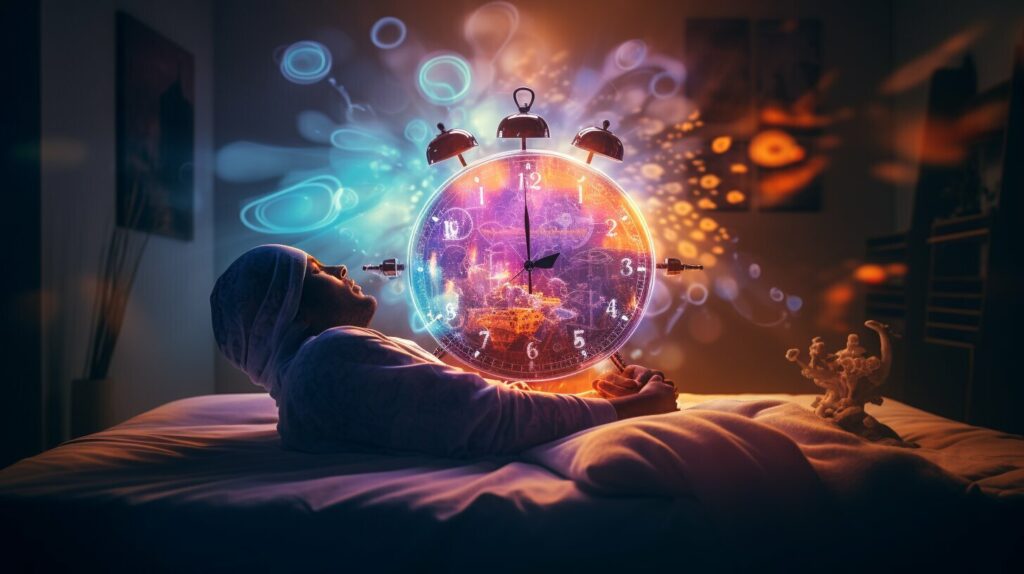*This post may contain affiliate links for which I earn commissions.*
Do you ever wake up feeling exhausted despite a full night’s sleep? Are you asking yourself, how can I sleep dreamless? Do you often have vivid dreams that disturb your rest?
If so, you may be experiencing a sleep disorder that interferes with your ability to achieve deep sleep and dreamless rest. Fortunately, there are several techniques you can try to help you achieve uninterrupted, peaceful rest.
In this article, we will explore the stages of sleep, the role of dreams, ongoing research on dreamless sleep, and the relationship between sleep behavior and achieving dreamless rest. We will also discuss the potential implications of dreamless sleep for memory formation and the diagnosis and treatment of sleep disorders.
Key Takeaways:
- Deep sleep and dreamless rest are essential for overall sleep quality.
- Understanding the different sleep stages and their importance can help achieve uninterrupted sleep.
- The categorization of dreamless sleep into different states may provide new insights into sleep behavior and experience.
- Studying dreamless sleep can enhance our understanding of sleep disorders and provide new avenues for treatment.
Understanding Sleep Stages and the Role of Dreams
Getting enough sleep is important for your overall health and well-being. However, falling asleep and staying asleep can be challenging for many people, especially those with sleep disorders. To understand how to achieve dreamless sleep, it’s important to first understand the different stages of sleep and the role of dreams in the sleep cycle.
The sleep cycle is divided into four stages: stage 1, stage 2, stage 3, and rapid eye movement (REM) sleep. A different brain wave pattern characterizes each stage and serves a different purpose. Stage 1 is the lightest stage of sleep, while stage 3 is the deepest stage of non-REM sleep. REM sleep, on the other hand, is associated with vivid dreams and rapid eye movements.
Insomnia, a common sleep disorder, can make it difficult to fall asleep and stay asleep, affecting your sleep quality. Without enough of each sleep stage, you may feel groggy and tired during the day, affecting your productivity and mood.
While dreams are often associated with REM sleep, they can occur in any stage of sleep. Dreams can help the brain process emotions and memories, which are essential to the sleep cycle.
Understanding the different stages of sleep and the role of dreams can help you develop strategies to achieve dreamless sleep and improve the overall quality of your sleep.

Exploring Dreamless Sleep: Research and Discoveries
If you experience vivid dreams and struggle to achieve deep, uninterrupted sleep, you may wonder if dreamless sleep is even possible. While more research is needed to fully understand this state of sleep, recent studies offer new insights into achieving dreamless rest and its potential impact on sleep quality and overall well-being.
Researchers at the University of British Columbia are investigating the impact of dreamless sleep on sleep quality and duration. By monitoring brain activity in participants while they sleep, they aim to better understand how dreamless sleep contributes to our overall sleep experience.
One study found that individuals who experienced longer periods of dreamless sleep reported a better quality of sleep overall. By shedding light on the characteristics of dreamless sleep, researchers hope to develop new treatments for sleep disorders that currently impact millions of individuals worldwide.

While the research is ongoing, understanding the importance of achieving dreamless sleep can provide new avenues for improving sleep quality. By prioritizing deep sleep and exploring different sleep positions that can contribute to achieving dreamless rest, you can take steps towards a more restful night’s sleep.
Categorizing Dreamless Sleep: New Insights and Findings
As sleep research continues, categorizing dreamless sleep into different states is becoming increasingly popular. This approach has potential benefits, as it can help us understand the exact roles of different sleep stages. For example, some sleep states may not involve dreamless sleep at all, while others might feature different combinations of sleep stages. By categorizing dreamless sleep, we could gain new insights into the effects of sleep position, sleep deprivation, and other factors on different types of sleep experiences.
One potential way to categorize dreamless sleep is based on the different sleep stages involved. For example, some studies have suggested that dreamless sleep may involve a distinct stage of sleep, such as slow-wave sleep. Other research has proposed that dreamless sleep might result from interactions between different sleep stages. Still, other studies have suggested that dreamless sleep might occur during different parts of the sleep cycle.

The impact of factors like sleep position and sleep deprivation on dreamless sleep may also depend on these different categories. For example, one study found that sleeping on your left side could increase the occurrence of dreamless sleep during a specific part of the sleep cycle. Another study found that sleep deprivation can affect sleep quality differently depending on the sleep stage, potentially leading to more or less dreamless sleep depending on the individual.
Better Sleep Quality
Overall, exploring the different categories of dreamless sleep could provide new insights into the overall nature of sleep and how it interacts with other factors like sleep disorders. By understanding the precise relationships between different sleep stages and dreamless sleep, we may be able to develop more effective treatments for sleep disorders that can help individuals achieve better sleep quality.
Shedding Light on Dreamless Sleep: The Relationship with Sleep Behavior
Have you ever wondered why you sometimes wake up feeling refreshed and without recollection of dreams? It could be that you experienced dreamless sleep, which is characterized by a lack of vivid dream experiences. Understanding dreamless sleep can provide insight into your sleep behavior and overall sleep quality.
One study conducted by researchers at the University of Arizona found that sleeping on your left side can increase the likelihood of dreamless sleep. The study found that participants who slept on their left side experienced decreased dream frequency and intensity. This could be due to the way the brain processes information during sleep.

Additionally, dreamless sleep is often experienced during the non-REM stages of sleep, particularly stage 3 and stage 4. These stages are characterized by deep sleep and are crucial for maintaining good sleep quality. During these stages, the body repairs itself, and the brain clears toxins and consolidates memories, which is essential for learning and cognition.
It’s important to note that dreamless sleep is not the same as restless sleep or sleep deprivation, which can also impact sleep quality and overall health. Restless sleep and sleep deprivation can lead to various health issues, including mood disorders, decreased cognitive function, and a weakened immune system.
By understanding the relationship between sleep behavior and dreamless sleep, you can improve your overall sleep quality and wake up feeling more rested and refreshed.
Understanding Dreamless Sleep: Interactions between Sleep Stages
If you’re wondering how to achieve dreamless sleep, it’s essential to understand the interactions between different sleep stages. While dreamless sleep can occur in any stage of sleep, it has a unique relationship with non-REM (rapid eye movement) sleep.
Non-REM sleep is divided into three stages: N1, N2, and N3. N1 is the lightest stage, while N3 is the deepest stage of sleep. When you first fall asleep, you enter the N1 stage, followed by N2 and N3. After N3, you usually return to N2 and N1 before entering the first REM stage.
During non-REM sleep, your brain activity slows down, and your muscles relax. This state is crucial to your body’s restorative processes and helps regulate mood, appetite, and energy levels. Dreamless sleep can occur during any non-REM stage, but it is most common in the N3 stage.
Research has suggested that dreamless sleep in the N3 stage may be related to “sleep spindles.” Sleep spindles are brief bursts of brain activity that occur during the N2 and N3 stages of sleep. They are associated with the consolidation of memories and the enhancement of learning. Studies have shown that the number and duration of sleep spindles during non-REM sleep are associated with better cognitive function and memory consolidation.
These findings suggest that looking at dreamless sleep could enhance our understanding of sleep disorders and our ability to develop more effective treatments. By better understanding the interactions between different sleep stages, we may be able to identify specific sleep patterns associated with particular sleep disorders, such as insomnia or sleep apnea.

Dreamless Sleep Categories: Shedding Light on Sleep Experience
The categorization of dreamless sleep has been a topic of interest for researchers studying the different stages of sleep. These distinctions may provide new insights into the exact relationship between sleep behavior and sleep experience.
One proposed category of dreamless sleep is N3, the deepest stage of non-REM sleep. During this stage, the body undergoes restorative processes, such as the repair of tissues and the release of growth hormones. Another proposed category is N2 sleep, during which the brain consolidates memories and processes emotions.
Further research is needed to fully understand the interactions between these different sleep stages and the prevalence of dreamless sleep within them. However, looking at dreamless sleep could enhance our understanding of sleep disorders and how they affect our overall sleep quality.

One interesting finding related to dreamless sleep is the impact of sleeping position on its occurrence. Research suggests that individuals who sleep on their left side are more likely to experience NREM sleep, including dreamless sleep. This highlights the importance of sleep position in achieving quality sleep.
Additionally, it is essential to note that dreamless sleep is not the only state that involves restorative processes. The twitches that occur during sleep, known as hypnic jerks, are also a part of the body’s restorative processes and occur during the transition from wakefulness to sleep.
Dreamless Sleep and Its Role in Memory Formation
You’re not alone if you’ve ever woken up to find your partner twitching in their sleep. These twitches, or hypnic jerks, are expected during the transition from wakefulness to sleep. But what role do they play in our overall sleep experience and memory formation?
Research on dreams and sleep has shown that we consolidate memories during sleep; dreamless sleep is no exception. In fact, some studies suggest that dreamless sleep may play an even more significant role in memory consolidation than REM sleep, during which we typically experience vivid dreams.
During dreamless sleep, the body undergoes a process called sleep spindles, brief bursts of brain activity that are thought to help transfer memories from short-term to long-term storage. These sleep spindles occur during Stage 2 of non-REM sleep, a stage that typically makes up the majority of our sleep time.
So, if you want to improve your memory and cognitive function, don’t overlook the importance of dreamless sleep. Incorporating the tips and techniques mentioned earlier in this article can help you achieve more uninterrupted, restful sleep and optimize your body’s natural memory consolidation processes.

Dreamless Sleep: Implications for Sleep Disorders and Treatment
If you suffer from sleep disorders, dreaming can often exacerbate the problem, causing interruptions throughout the night. Understanding how dreamless sleep can help improve your sleep quality and reduce the symptoms of a sleep disorder is essential.
Research has shown that dreams and sleep states could play a critical role in maintaining healthy sleep patterns. It is not just that this state involves dreamless sleep but rather that specific sleep stages relate to it.
By looking at the connection between different sleep stages and dreamless sleep, we can gain insights into how sleep disorders work and how they can be effectively treated. With this information, doctors and sleep specialists can develop more effective treatment plans for patients with sleep disorders and help them achieve a night of more restful and peaceful sleep.

For example, one study conducted by the University of British Columbia found that sleeping on your left side can increase the likelihood of experiencing dreamless sleep. This knowledge alone could help sleep specialists identify strategies to help patients with sleep disorders achieve dreamless sleep.
Moreover, research has shown that the twitches that occur during sleep, which is part of dreamless sleep, play a crucial role in memory consolidation during sleep. This insight could help explain the significance of dreamless sleep and its role in overall sleep quality, memory, and cognitive function.
Understanding the relationship between dreamless sleep, different sleep stages, and sleep disorders can help us develop new sleep treatment and management strategies. These strategies could involve new ways to optimize sleep position, modify sleep behavior, and eliminate sleep disorders.
Therefore, exploring the potential benefits of dreamless sleep and its role in sleep quality and overall well-being is essential if you suffer from sleep disorders. With the right strategies, you can improve your sleep quality and wake up feeling refreshed and energized.
Conclusion
You can use several tips and techniques to achieve dreamless sleep and improve your overall sleep quality. By understanding the different stages of sleep and their importance, you can work towards achieving uninterrupted and deep sleep.
Ongoing research on dreamless sleep, including studies by the University of British Columbia, sheds light on the importance of this state of sleep for our overall well-being. By understanding the different categories of dreamless sleep, we can gain new insights into how sleep behavior influences sleep experience.
Furthermore, the connection between dreamless sleep and memory consolidation highlights the importance of achieving quality sleep for proper cognitive functioning.
Overall, incorporating the tips and techniques mentioned throughout this article can help you achieve dreamless sleep and feel refreshed. By understanding the interactions between different sleep stages and the potential implications of dreamless sleep for sleep disorders and treatment, we can work towards improving our sleep quality for a healthier lifestyle.
FAQ
Q: What is dreamless sleep?
A: Dreamless sleep refers to the state of sleep where there are no dreams or conscious awareness of dreams.
Q: How can I achieve dreamless sleep?
A: To achieve dreamless sleep, it is vital to create a comfortable sleep environment, establish a regular sleep routine, and practice relaxation techniques such as meditation before bedtime.
Q: What are some tips for uninterrupted peaceful rest?
A: Some tips for uninterrupted peaceful rest include keeping a consistent sleep schedule, avoiding caffeine and electronic devices before bed, creating a soothing sleep environment, and practicing relaxation techniques.
Q: Does everyone experience dreamless sleep?
A: Yes, dreamless sleep is a natural part of the sleep cycle that occurs for everyone.
Q: Are there different stages of dreamless sleep?
A: Currently, research suggests that dreamless sleep is a state that occurs during non-REM sleep, which is further divided into different stages of sleep.
Q: How does dreamless sleep benefit us?
A: Dreamless sleep plays a vital role in emotional processing, memory consolidation, and allowing the brain to rest and restore its functions.
Q: Can dreamless sleep help with sleep disorders?
A: Understanding the different categories of dreamless sleep and their impact on brain functions can help diagnose and treat sleep disorders.
Q: Are there any sleep disorders related to dreamless sleep?
A: Yes, sleep disorders such as insomnia and sleep apnea can affect the quality and occurrence of dreamless sleep.
Q: How does dreamless sleep affect consciousness?
A: During dreamless sleep, consciousness may not completely disappear but rather shift into a different state of awareness.
Q: Are there any cultural or historical references to dreamless sleep?
A: Yes, in Indian and Tibetan philosophies, some explanations involve distinct sleep states, including dreamless sleep.







